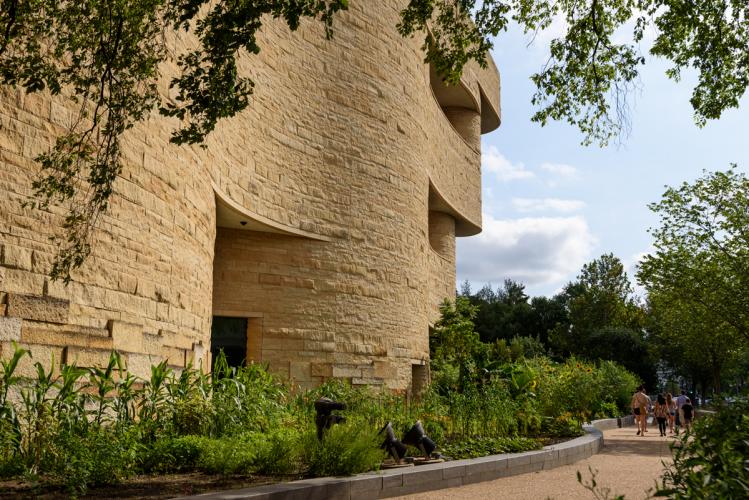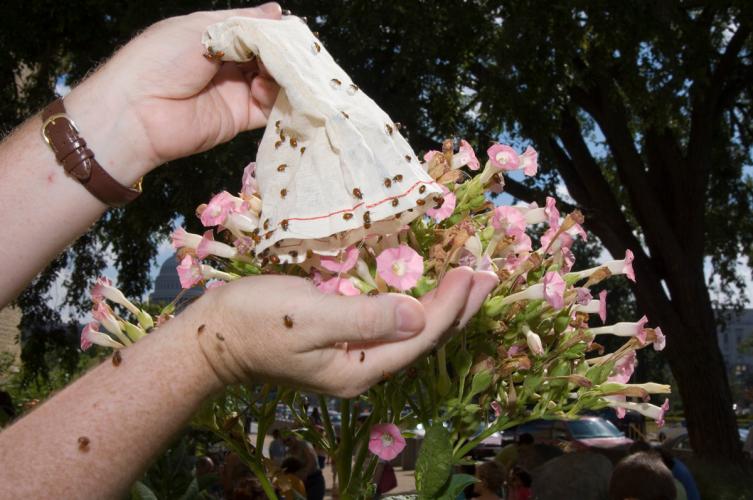A stroll around the outside of the National Museum of the American Indian in Washington, D.C., is as much an exploration of Indigenous cultures as any of the exhibitions within. Even as the building was being designed beginning in 1993, its landscape was carefully planned to be an integral part of the museum and a reflection of the many cultures it represents.
Anchoring the museum’s grounds are huge rocks from across the Americas, each marking one of the four directions. Architectural features such as contrasting stone blocks in the walkways or walls connects them visually to the building’s exterior and then lead inside, “blurring the lines between building and landscape, indoors and out,” writes architect and NMAI Project Manager Duane Blue Spruce (Laguna/Ohkay Owingeh Pueblo) in the book “The Land Has Memory: Indigenous Knowledge, Native Landscapes, and the National Museum of the American Indian.”
The great rocks sit within four different habitats encircling the building: hardwood forests, wetlands, croplands and meadows. These environments offer a sampling of plants Native Americans have grown for food, fiber, dyes, medicines or ceremonial purposes, explained Christine Price-Abelow, the Smithsonian Gardens horticulturist who manages the landscape.
The oldest boulder faces north. It is a 1,600-pound, 4-billion-year-old piece of Acasta gneiss from Canada’s Northwest Territories, identified with the help of a Tlicho (Dogrib) community in the region. The woodlands continue on the north side of the building and feature hardwoods such as hickory, tulip poplar and walnut—trees that have provided materials for baskets or dyes as well as nuts. Interwoven among the trees are sassafras for tea, witch hazel for skin tonic, and fibrous Indian hemp for cords, along with bloodroot, ferns and blooming plants such as bluebells and phlox. A flat-sided stone on the edge of the woods reflects the sound of water cascading next to the building, an echo of Tiber Creek, which once flowed through this area.
The eastern rock lies by the wetlands. The half-billion-year-old quartzite boulder came from Dickerson, Maryland, and was placed between the museum and the U.S. Capitol to encourage diplomatic relationships between Native nations and the federal government. In the wetlands, ducks can be seen paddling across a pond surrounded by dogwoods, red maples, willows, cattails and trout lilies. Paw paw trees offer their sweet, short-lived fruits in the summer. Bald cypress trees, which grow in swampy areas and have roots that poke above the water, have been used by the Seminole peoples of Florida to make dugout canoes.
A boulder from Chile’s Tierra del Fuego—which is home to the world’s southernmost Indigenous community, the Yagán peoples—anchors the croplands on the south side of the building. Edible plants like Cherokee corn, Seminole pumpkin and rattlesnake pole beans grow along with peanuts, potatoes, sunflowers, tomatillos and other foods. Poblano, Hatch, serrano and other peppers occasionally contribute their heat to dishes in the museum’s Mitsitam Cafe.
During warm months, the Three Sisters—corn, beans and squash—live companionably here. The bean vines ascend the cornstalks as microbes on their roots convert nitrogen in the air into fertilizer for all three plants, while the broad squash leaves cover the ground to minimize evaporation and suppress weeds.
A dark piece of basalt cast up from the Earth’s molten interior has traveled from Hawai‘i Volcanoes National Park to mark the meadow on the west side of the building. This rock is on extended loan to the museum, as permanently removing stones from the Hawaiian Islands’ volcanoes is forbidden.
The meadow is carpeted with long-stemmed grasses, accompanied by medicinal plants such as echinacea, goldenrod and bee-balm. In mid-winter, the meadow was packed with stalks of dry plants and grasses, left for wildlife to eat. “We wait to cut them down in late spring because pollinating insects lay their eggs in the stalks to overwinter,” said Price-Abelow.
Here, eastern red cedar is the dominant tree. Its wood repels insects and resists rot, so Indigenous peoples have used it for fence posts, furniture, carvings, tipi poles and other outdoor structures, as well as planks for cooking salmon. Nearby sumac supplies dye from its flowers and tea from its leaves. For those who know how to prepare them, young pokeweed leaves make a tasty salad and the plant’s mature berries could be a source of deep purple dye.
The “Hawaiian Canoe Garden” tucked into a corner of the croplands is home to the plants Pacific Islanders carried on their double-hulled canoes as they voyaged from Polynesia to Hawaii hundreds of years ago. Sweet potato, palms, ti plants, kukui [candlenut] and taro are among the plants raised in the Smithsonian Gardens Greenhouse and replanted at NMAI annually during the summer.
All of the landscape is managed with nature-friendly techniques. For example, instead of mowing and raking the grounds before winter, dead leaves and stalks are left until spring to suppress weeds, retain soil moisture and reduce erosion while the decaying plants contribute to the soil’s fertility. Also, rather than using pesticides, insects such as aphids are controlled by convergent ladybugs—beetles that families have helped Smithsonian Gardens and NMAI staff release onto tobacco plants grown here for gifts and ceremonial purposes, said NMAI imagiNATIONS Activity Center manager Adrienne Smith (Cherokee/Muscogee [Creek]).
Each year, Price-Abelow orders Indigenous seeds and plants from several providers to replenish the garden. One of those is Native Seeds/SEARCH in Tucson, Arizona, a nonprofit organization that typically offers seeds to Native communities and other individuals in the Southwest with cultural connections to the seeds. “Our approach is conservation through distribution,” said Andrea Carter (Powhatan Renape), Native Seeds/SEARCH’s outreach agronomist. “While the climate in the East differs markedly from that of Arizona, these seeds will still hold up well in summer. Plants can adapt to harsher or milder climates and different soils.”
Another touch of the Southwest will arrive in the croplands during NMAI’s Living Earth Festival in April. Reyna Banteah is a member of the Zuni Agriculture Committee, which will demonstrate how to create a “heck’o:we,” or “waffle garden” built of a grid of elevated clay and soil. “Traditionally, building and caring for the gardens was a family affair, led by the women,”said Banteah, who teaches youth about Zuni farming techniques. “The adobe walls retained water and protected the plants from wind to reduce evaporation.”
Whatever their origins, crops and trees, rocks and shrubs, grasses and water unite to weave a circle around the museum like the seasons circle the year. Together, the landscape is a reminder of the importance of place and plants in the world of Indigenous peoples, said Smith. “Plants hold a place in our creation stories, and we know what plants we can use for food, medicine, dyes or ritual,” she said. “These gardens contain the knowledge that we learn and pass on and keeps us connected to our culture.”


